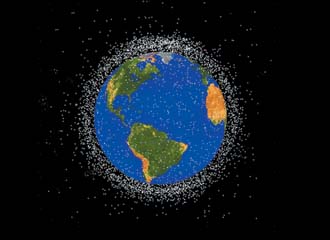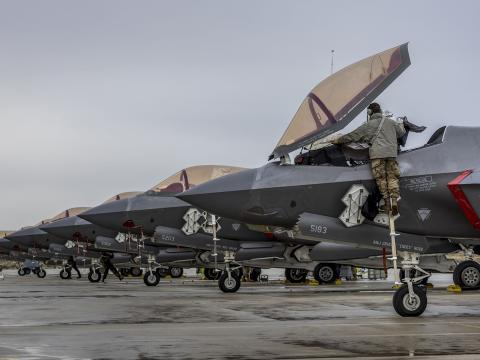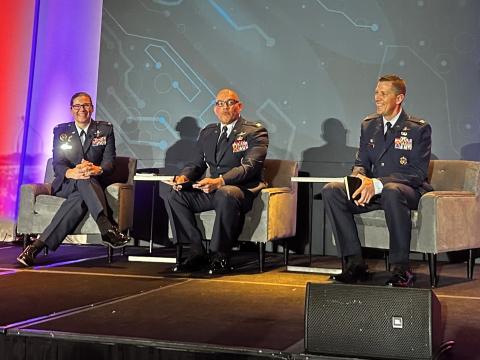Not Your Granddad's Space Fence
A variety of objects ranging from active satellites to space debris increasingly crowd near-earth space.
The U.S.Air Force aims to replace its obsolete space debris detector. 
Space is not so spacious anymore. The Earth is orbited by hundreds of active satellites. In addition, thousands of pieces of space junk both natural and manmade—defunct satellites, pieces of booster rockets, lost astronaut tools, and even an empty space suit—form a veritable junkyard floating around the planet.
Small objects traveling at hypervelocity—several kilometers per second or more—can pose a grave danger to spacecraft. Paint flecks have been known to damage space shuttle windows.
The United States currently keeps a catalogue and tracks space debris objects with the aging and outdated very high frequency Air Force Space Surveillance System, which has been in service for 50 years. In 2015, the country intends to replace the aged system with a fresh-faced Space Fence, a modern-era, S-band radar-based system designed to be the planet’s most accurate space situational awareness sensor for objects in low-earth orbit.
The fence will be created by strategic placement of multiple radars that cover enough continuous area to track objects as they enter the Earth’s orbit at certain angles. Space Fence will provide several advantages over its predecessor. The legacy system, for example, is referred to by users as a dumb system because it continually stares off into the same area of space. Space Fence will be a smarter, cued system, meaning operators at the Joint Space Operations Center (JSpOC), Vandenberg Air Force Base, California, will be able to aim the radars in specific directions whenever necessary. In addition, the older system can see objects the size of a washing machine from about 1,000 kilometers, whereas Space Fence will be designed to spot objects the size of a golf ball. It also will be able to better distinguish between two objects that are close together. Additionally, Space Fence will be faster and more nimble, updating the database of registered space objects more frequently than its forerunner.
“The past system was fielded in 1961, so it’s your grandfather’s radar,” says Linda Haines, Space Fence program manager for the U.S. Air Force. The capabilities of modern S-band radars using high-powered amplifiers are significantly improved over the past space fence. “The primary mission of Space Fence is to identify things in low-earth orbit that are potentially a danger to our space assets. It’s one of the largest S-band phase arrays ever built in the world, and that obviously comes with some potential technical challenges, although it is on track to reach all maturity levels required in this phase of the program.”
The JSpOC also is being modernized to improve command and control of the Space Surveillance Network, of which Space Fence will be one piece. It primarily is up to the JSpOC to share the data with those who need it. “JSpOC will be the primary customer of the Space Fence data, but it’s going to be a network-centric system, so it will provide information through the Global Information Grid to any authorized users. We’re working things out with the 14th Air Force and the JSpOC as to what the business rules will be,” Haines says. “The JSpOC and Strategic Command have different data sharing arrangements with various space-going countries around the world, so they control how that data is shared. A lot of our data today is shared, depending on those bilateral or multilateral agreements.”
The Government Accountability Office (GAO), the nonpartisan investigative arm of Congress, criticized Space Fence earlier this year in a report on space situational awareness. Haines, however, takes exception to the GAO’s assessment. “They said the number-one risk to Space Fence is that the JSpOC modernization will not be ready once the fence is fielded, but that is not accurate. That is not a risk to my program. Space Fence can accomplish its mission and go operational whether you have the modernization of the JSpOC or not,” Haines contends.
She volunteers, however, that JSpOC modernization will allow the Air Force to take full advantage of Space Fence capabilities. “We’re linked or intertwined so that in order to get the full military utility of the system, you do need the fully upgraded capabilities of the [JSpOC] just to expand the catalogue, for example. When they established the space catalogue years ago, they couldn’t imagine more than 100,000 objects, so they have codes that are limited to that, and they have to expand the codes.”
Another threat, according to the GAO, is that the technology is immature and, therefore too risky but Haines counters that the GAO used faulty data. In fact, Haines reports, the two contractors building prototypes either have reached technology maturity level six already or will do so in January. “The report had outdated information on the technology maturity, and [the data] was several years old. We have very mature technology that’s going into this system,” she contends.
Haines also reports that the Air Force has slashed potential life-cycle costs of the program by 65 percent, in large part by using commercial technologies developed for cellular telephones. “We’re talking tens of thousands of transmit elements and potentially hundreds of thousands of receive elements. We’re able to use, for instance, very low-cost amplifiers. We’re talking about costs in dollars versus costs in thousands of dollars just because of the volume that we’re going to be purchasing,” she reveals.
In addition, the radar originally was expected to be 10 times the size of the Cobra Dane radar in Shemya, Alaska, which is used for ballistic missile defense. Cobra Dane is about 120 feet tall and has a radar face approximately 95 feet in diameter. “If [Space Fence] were monostatic—which means it has both a transmit and receive aperture together—there was a concern a monostatic radar that large would fry everything in sight, and the thing would just be impossible to build in an affordable way,” Haines says. “We’ve been able to reduce the size so that it is a little larger than one Cobra Dane, so that’s a significant decrease.”
The Air Force Electronic Systems Center, Hanscom Air Force Base, Massachusetts, released a request for proposals in October 2010, and in January awarded two preliminary design review contracts—one to Raytheon Integrated Defense Systems and the other to Lockheed Martin Mission Systems and Sensors Division. During the 18-month period of performance, the two companies are expected to develop preliminary designs, as well as radar performance analysis, evaluations and prototypes. Their work is intended to address critical technology elements and manufacturing processes, technical risks, life-cycle costs, schedule and performance risk for the estimated $3.5 billion program.
The system architecture will need to be approved by the secretary of the Air Force and the secretary of defense, following a decision by Gen. William Shelton, USAF, who leads Air Force Space Command. The architecture will include two or three geographically dispersed, ground-based radars to provide more detailed, accurate and timely assessments of the debris field. Possible locations for the ground sensors include Australia, Kwajalein Atoll and Ascension Island. Both Kwajalein Atoll and Ascension Island are near the equator. “We have a space situational awareness partnership with Australia, and part of the discussion with Australia is what role [that country] might want to play in programs such as Space Fence. There are no final decisions yet,” Haines reports.
The final contract will be awarded in summer 2012, and the system is expected to be operational in 2015. Meanwhile, the debris field the Space Fence will track continues to grow. In a highly publicized event two years ago, a Russian satellite and a privately owned U.S. communications satellite collided near the North Pole, producing clouds of debris. In addition, China was widely denounced by other nations in 2007 after destroying one of its own satellites in orbit. With Space Fence in place, the United States will have a dramatically clearer picture of exactly how many objects pose a threat to spacecraft, according to Haines. “Once Space Fence goes operational, we’re going to be seeing hundreds of thousands of objects that we’re not currently identifying or tracking,” she says.
WEB RESOURCES
Hanscom Air Force Base: www.af.mil/news/story.asp?id=123161377
NASA: http://earthobservatory.nasa.gov/IOTD/view.php?id=40173



